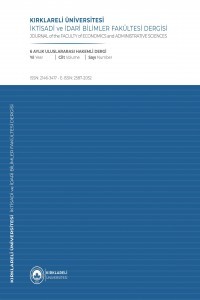KIRILGAN SEKİZLİ ÜLKELERİNİN ORTA GELİR TUZAĞINA UZAKLIĞININ ÖLÇÜLMESİ: KARŞILAŞTIRMALI BİR ANALİZ
İktisadi Büyüme, Orta Gelir Tuzağı, Kırılgan Beşli
MEASURING THE RANGE OF FRAGILE EIGHT COUNTRIES TO THE MIDDLE-INCOME TRAP: A COMPARATIVE ANALYSIS
Economic Growth, Middle-Income Trap, Fragile Five,
___
- Aiyar, S., Duval, R., Puy, D., Wu, Y., Zhang, L. (2013). Growth Slowdonws and the Middle Iincome Trap (IMF Working Paper No. 13/71). IMF’den alıntılanmıştır: https://www.imf.org/external/pubs/ft/wp/2013/wp1371.pdf
- Bal, D. P., Dash, D. P., Subhasish, B. (2016). The Effects of Capital Formation on Economic Growth in India: Evidence from ARDL-Bound Testing Approach. Global Business Review, 17(6), 1388–1400. https://doi.org/10.1177/0972150916660403
- Barro, J., R. (1996). Determinants of Economic Growh: A Cross-Country Empirical Study (NBER Working Paper No.5698). NBER’den alıntılanmıştır: http://www.nber.org/papers/w5698.pdf
- Barro, R. J. (2000). Education and Economic Growth. Mimeo, Harvard University.
- Benhabib, J., Spiegel, M. M. (1994). The Role of Human Capital in Economic Development Evidence from Aggregate Cross-Country Data. Journal of Monetary Economics, 34(2), 143-173.
- Bengoa, M., Sanches-Robes, B. (2003). Foreign Direct Investment, Economic Freedom and Growth: New Evidence from Latin America. European Journal of Political Economy, 19(3), 529-545.
- Bilbao‐Osorio, B., Rodríguez‐Pose, A. (2004). From R&D to Innovation and Economic Growth in the EU. Growth and Change, 35(4), 434-455. Blattman, C., Hwang, J., Williamson, G., J. (2003). The Terms of Trade and Economic Growth in the Periphery (NBER Working Paper No. 9940). NBER’den alıntılanmıştır: http://www.nber.org/papers/w9940
- Bozkurt, E., Bedir, S., Özdemir, D., Çakmak, E. (2014). Orta Gelir Tuzağı ve Türkiye Örneği. Maliye Dergisi, 167, 22-39.
- Cheng, C., Dai, L. (2014). The Middle Income Trap, Branching Deregulation, and Political Influence. Erişim Tarihi: 11 Ekim 2017, https://scholar.princeton.edu/sites/default/files/liangdai/files/bank_deregulation_and_political_contribution-1_7.pdf
- ISSN: 2146-3417
- Yayın Aralığı: Yılda 2 Sayı
- Başlangıç: 2012
- Yayıncı: Kırklareli Üniversitesi
DUVAR: TARİH GERİ DÖNÜYOR - DENİZ ÜLKE ARIBOĞAN (KİTAP İNCELEMESİ)
İZMİR İKTİSAT KONGRESİ’NİN TÜRK DIŞ POLİTİKASININ İNŞASINDAKİ ROLÜ
Ufuk ÖZER, Mehmet Hanefi TOPAL
AKADEMİSYENLERİN ÖRGÜTSEL SESSİZLİK ALGILARI: KONUYA İLİŞKİN BİR UYGULAMA
Betül BALKAN AKAN, Feyza Çağla ORAN
TÜRK BANKACILIĞINDA KRİZLER VE ÇIKARILAN DERSLER
Süleyman KALE, Mehmet Hasan EKEN
BEZDİRİ İLE MÜCADELEDE DURKHEİM'IN AHLAK EĞİTİMİ MODELİ
ORGAN BAĞIŞINDA KAMU SPOTU ETKİSİNİN NİTEL TERCİH MODELLERİ İLE ANALİZİ
KEVSER TÜTER, ESİN CUMHUR YALÇIN
TÜRKİYE’DE HAYAT BOYU ÖĞRENMEDE SÜREKLİ EĞİTİM MERKEZLERİNİN ROLÜ VE ÖNEMİ
Hanife CANDIR ŞİMŞEK, Emel İSLAMOĞLU, Sinem YILDIRIMALP
KIRILGAN SEKİZLİ ÜLKELERİNİN ORTA GELİR TUZAĞINA UZAKLIĞININ ÖLÇÜLMESİ: KARŞILAŞTIRMALI BİR ANALİZ
